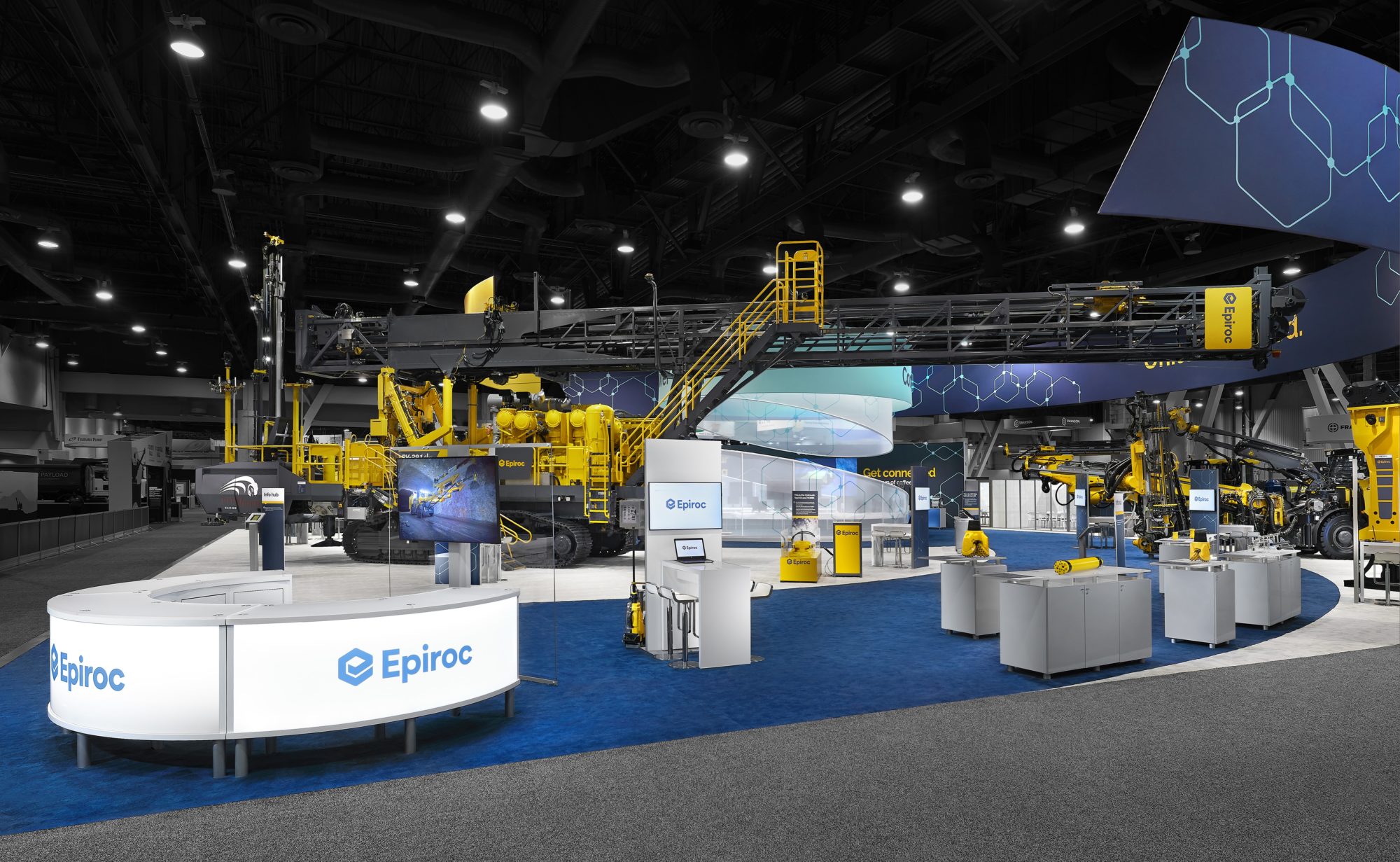MINExpo was a great opportunity to catch up with global mining technology player Epiroc on its latest surface and underground innovations. IM Editorial Director Paul Moore spoke in person with Tyler Berens, Automation Director Surface Mining; Adrian Speer, Product Line Manager Blasthole Drilling and Travis Battley, Underground Business Manager North America
One of the things Epiroc highlighted at MINExpo was its 6th Sense philosophy that ties back to how it connects the autonomy and digitalisation value chain for its mining customers. 6th Sense as an approach breaks down into a number of tangible layers including down to the machine level. And the final big piece of the autonomous drilling puzzle was put in place in Las Vegas with the launch of Epiroc’s Auto Bit Changer (ABC) system which was displayed on the Pit Viper 291 blasthole drill at the show.
Tyler Berens commented: “This is a ground up, very holistic design. It will be available on the 270 and 290 series of Pit Viper rotary drills first off. And while it might just look like a big box of bits attached to the drill – a lot of technology went into it. It has a top deck position which was the best fit for robotic operation and serviceability. It is based on a fully automated carousel design with one bit on the string and three more in the carousel. Plus they can be different sizes if mix and match is needed as the formation geology changes.”
Despite various efforts to get people out of the line of fire in bit changing, including prototypes from other OEMs, Berens says this represents the first true commercial autonomous bit changer on the market in terms of achieving live work elimination. It is equally applicable on an autonomous drill or conventional operator-controlled drill and was designed to be that way as an independent technology.
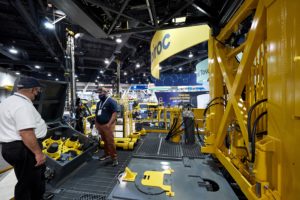
Epiroc’s new Auto Bit Changer on the PV-291 at the show
Berens adds: “It is designed to be directed from the operator whether that be an on-drill cab or via a teleremote operation – at the push of a button the bit is broken out and meets the drill string at the right angle and after it is fitted with error checks to make sure it is positioned correctly, the next bit is positioned ready to be used. It can also be operated as part of a fully autonomous drill set up.”
Berens said several Auto Bit Changer systems have been produced, with the first already in field trials at a mine on a PV-271 drill as a retrofit. This retrofittable aspect is crucial to be able to apply the safety benefits to the installed base of drills. “There are more than 800 Pit Vipers running out there – so it wouldn’t have made sense to not make it workable with those.”
For new drills ordered, Auto Bit Changer will still be an option, but Berens said a number of major customers are looking to standardise their blasthole drilling operations with it. Plus it isn’t just a safety benefit, it has a major efficiency benefit by getting rid of a lot of delays and downtime associated with manual bit changes. “In manual changes, sometimes the bit is there ready to go, but often it isn’t. Then the operator has to get out of the cab, and there is a lot of heavy manual work in the actual changeout itself including sometimes cleaning the new bit that has been lying around. Plus in a very cold region the operator may need to put gloves and other equipment on. Typically this all takes 15 to 25 minutes – from bit change need to it being completed and the drill running again. This compares to just a few minutes for Auto Bit Changer – yes, it eventually needs a carousel change but only every four bits. Finally, the system has algorithms to recognise very slight dimension changes in bits from other OEMs even though there are meant to be standardised sizes – so it can work with any rotary bit not just those from Epiroc.”
Auto Bit Changer aside, Berens also highlighted a lot of drill control room improvements that have been made for Pit Viper including a brand new teleremote station design called CAP – Common Automation Platform. Epiroc just passed 1 million hours of teleremote (hands on joystick) blasthole drill operation worldwide. It has also achieved over 25 million metres of autonomous drilling.

Left to right: Tyler Berens, Adrian Speer, Paul Moore and Travis Battley
Berens made an interesting point also on how the focus of drill control rooms has changed – with the drill operator today becoming more of a process engineer. The drill control station used to be front and centre in the control room with the camera screens – today in autonomous operations it is off to the side and only used for certain tasks. The drill process engineer is coordinating other tasks like coordinating drill plans, while the drill just gets on with drilling. There has also been a change in the number of drills being monitored – in the early days it was one drill per operator – today it is the norm in an autonomous drilling set up for one person to be monitoring large number of drills and even more than one drill group drilling different patterns. At an Integrated Remote Operations Centre scale, individuals are overseeing drilling across a whole mine or even several mines. The evolution has come down to a lot of human interaction analysis – what does that operator need in terms of information to be able to effectively monitor multiple machines – and a lot of this is keeping it to the bare minimum and leave things like obstacle detection alarms to other safety related teams.
Plus, the market itself has also changed – because the technology is well proven, less customers are wanting to take a gradual building blocks approach to autonomy – today then want to go straight to full autonomous drilling to be able to get the productivity benefits that brings from day one. “Epiroc’s autonomous drills today are smart enough and our systems are mature enough that it is no longer a big issue to go straight to full autonomy and focus efforts on the people and processes side.”
Lastly, as the Epiroc autonomous drilling technology continues to evolve does it put these drills beyond the reach of third party solutions? “It is definitely becoming harder for them with our drills to be able to get control of certain functions. Plus the ability to tap into our systems becomes much more complicated as our technology evolves. We have designed our autonomous systems holistically to cover the mechanical, electrical and software aspects with the robotics piece on top. It is difficult to bolt this on afterwards. Our full solution is effectively a purpose built robot whereas a third party autonomy retrofit of our drill is not and does not have the same control over variables and therefore will have some loss of functionality. That said, I also think competition is great, and it also helps keep us innovating. And of course we support interoperability in the right places such as at the command and data level but down at the component level it is a more difficult case to make.” Berens also said that there have been quite a number of examples where Epiroc has been asked to replace a third party autonomy system with its system because the customer wants greater reliability and one complete holistic solution.
A new underground era is coming
Looking at the underground space, Battley said there were a lot of similarities in trends and focus areas. “I think one of the key things with Epiroc on the design side is the platform. The machine is the machine but then its about scalable automation. For the customer if you take a Simba production drill or a Scooptram loader as an example, they have the option to get it automation ready. But the network then has to be sufficient to allow for automation. You might get away with leaky feeder for a drill at a push but not for a mobile vehicle.”
Battley said the underground market relative to autonomy is also changing. It is no longer just about sectioned off areas of the mine – autonomy is now at the heart of the operation. Also, the focus on productivity and safety means there is less appetite for teleremote – for example where the operator needs to get in and out of the Scooptram as it goes into the open stope using Radio Remote Control. “The autonomous machine is not constrained by waiting for anything.” Epiroc was showcasing both a new autonomous control room for managing underground operations at MINExpo as well as Scooptram Automation Multi machine, and was demonstrating its functionality at the event. Scooptram Automation Multi machine creates a common information environment that controls a multiple fleet of loaders. The new operator station ergonomic environment gives an ideal and versatile working position with a graphical user interface designed for the operator making the operation intuitive and easy to use.
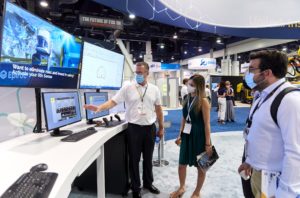
Epiroc was also highlighting interoperability including the Newcrest Mining Cadia East project where Epiroc was able to have an autonomous Scooptram load material from a draw point and unload into an ore pass while a unmanned MacLean secondary breaker with water cannon came in to clear up the area. “We took a modularised approach – MacLean took onboard some of Epiroc’s software on its machine, it allowed different OEM machines to operate simultaneously in the autonomous area – something we will look to do a lot more of going forward. Our customers want ancillary vehicles to be able to come into the autonomy area with permission and for operations to continue uninterrupted. Plus the remote operating stations in many cases are moving from the mine site to the large integrated ROC locations; plus as at surface, more unmanned machines being monitored by fewer operators.”
IM also asked Battley about the fusion between battery which is now coming at a rate of knots – with autonomy. “Our Scooptram ST14 Battery will be launched with autonomy very soon. Of course we already have autonomous capability of the ST14 today and have had for some years. The complexity of course is accounting for the battery swap or onboard fast charging – we offer both options – as part of the autonomous solution. Today our Scooptram ST14 Battery will run anything from three to five hours depending on the nature of the work such as whether it is going up or down ramp loaded.” Battley said running autonomous battery machines including with autonomous charging or battery swap is a major part of its work on the NEXGEN SIMS project. Epiroc is looking at several solutions, including the use of robotic arms for swapping and connectors. Of course there is also the option of overhead catenary trolley type charging underground – Epiroc already has a lot of experience with trolley underground via the Kiruna trolley trucks running at operations in Canada – and just as on surface Epiroc is also looking at options for trolley battery charge; including ongoing discussions with BluVein on interoperability with its proposed trolley charging system.
But Battley added: “The market is likely to evolve with the use of several DC power trolley type infrastructures underground – from BluVein, Siemens, ABB and others. Yes there’s an infrastructure cost and it has to be maintained but once its in place there are a lot of benefits. You can take power off the line going up ramp and even feed power back into the system down ramp if the battery is fully charged. If our Minetruck or Scooptram can be modularised to a point where a universal and interoperable connector can use any of these systems then there are no restrictions. Again, just as on surface, the underground transition to electric is likely to involve all three of battery swap, onboard stationary fast charging and catenary charging depending on the project, customer preference, mine setup etc..”
Battley added that the electric transition is being eased somewhat because the component manufacturers – electric motors, inverters, drives – have progressed in offering more industrial grade products suited to underground mining. “Plus with the batteries themselves, energy consumption is very important. You have a finite amount of energy available that you need to manage in terms of optimising auxiliary hydraulics so pumps are only used on demand.”
The next discussion topic was the fact that truck autonomy has lagged loader autonomy for various reasons such as more interaction with other vehicles on declines, and how it will evolve. “When you go into an existing mine, you may be hamstrung with certain things such as network bandwidth and mine design. But the beauty of the market today is that there is a lot of awareness among consultants, OEMs and miners of the importance to design any new mines with autonomy and potentially battery operation factored in. One option with regard to autonomous trucks is to have two declines – one dedicated to production mainly for the auto trucks only and one for utility traffic. Or you have a oneway system going down one decline and out of the other. For battery you can design you haulage accordingly with loaded downramps for energy recharge such as to a shaft bottom or lower level ore pass. Depending on the mine depth there will be a cut off where it will be cheaper to use battery trucks to ore passes only and haul the ore out via skips in the shaft. Equally, many mines today have a corkscrew decline – why not just have long straight declines with switchbacks? Trucks can average 15 km/h instead of 8 km/h so you need less trucks for the same production rate. And the traffic management is more streamlined. Plus these straight declines are much more amenable to rapid excavation and opens the door for using mechanical cutting technology.”
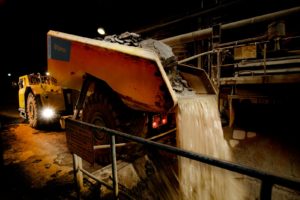
Finally, Battley mentioned some other strings in Epiroc’s bow – the software it has through Mobilaris for a minewide 3D visualisation tracking the process situation in real time. As an example, following what the ground support teams are doing – if it’s a bottleneck due to bolt shortages – making sure they are kept supplied with bolts ahead of time. Or on refuelling – avoid multiple vehicles being lined up at a fuelling bay at end of shift. And for battery fleets visualise charge levels of all the machines. Certiq telematics will bring in predictive maintenance information, show any loads and tonnes per shift. All that said – it is always best to only visualise the crucial data that affects productivity – you only need to know what you need to know.” Epiroc already has several mines in Canada operating with this technology. Mobilaris Onboard is another new development where you have a tablet in the cab plus the operator and machine are RFID tagged. It allows mine wide tracking but also improves traffic management as the operator themselves can see if other vehicles are also approaching an intersection, for example.
Larger diameter holes on a smaller platform
Last but not least, IM spoke to Adrian Speer about the new Pit Viper 291. “What we set out to do with the PV-291 was to put large diameter drilling on a smaller drill platform. Today the drills that do the big holes are monsters which gives them limitations such as where and how they can get in and out of production bench areas, plus as large machines they involve a larger investment. We were able to single out only the parts of the machine that needed to be sized to be able to do the large holes, and once that is in place why couldn’t we do it from a smaller platform?” It has taken over two years to improve the critical parts to the point needed and it has all been brought together on the new drill which is capable of 11-12 ¼ in holes with 9 ¼ pipe. But this is just the first step in a new series of 290 machines. The 291 at MINExpo was also a fully autonomous, cabless rig – Speer added: “this machine is at the top level of technology – there is no operator needed. When the machine needs to be trammed it can be done via teleremote even if that’s 1,000 km away.”
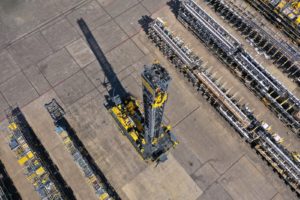
Berens added: “There’s also a local remote control mode – that’s how we got it into the Convention Center here. We got so much good feedback after displaying a cabless prototype at MINExpo 2016 – the Pit Viper 291 from a distance looks similar but it actually has a lot of subtle differences based on discussions with customers since then focussed on risk assessment at productivity. We have a lot of confidence in the new design.”
Speer said there is no cabless drill out there working at a customer site currently, but that PV-290 series rigs were already out there at multiple sites building up test operating hours. And of course like any other Pit Viper it has a diesel or tethered electric option. But is battery still some way off for blasthole rigs? “There are various avenues being looked at – I would say before battery where there are still power demand issues with the larger drills, this includes segmentation of power such as hybrid options and alternative fuels so we don’t need diesel engines to be running everything. For example you could run the air demand off another power source like a battery. Or use the battery for tramming then plug in a cable when it is stationary and drilling.”











